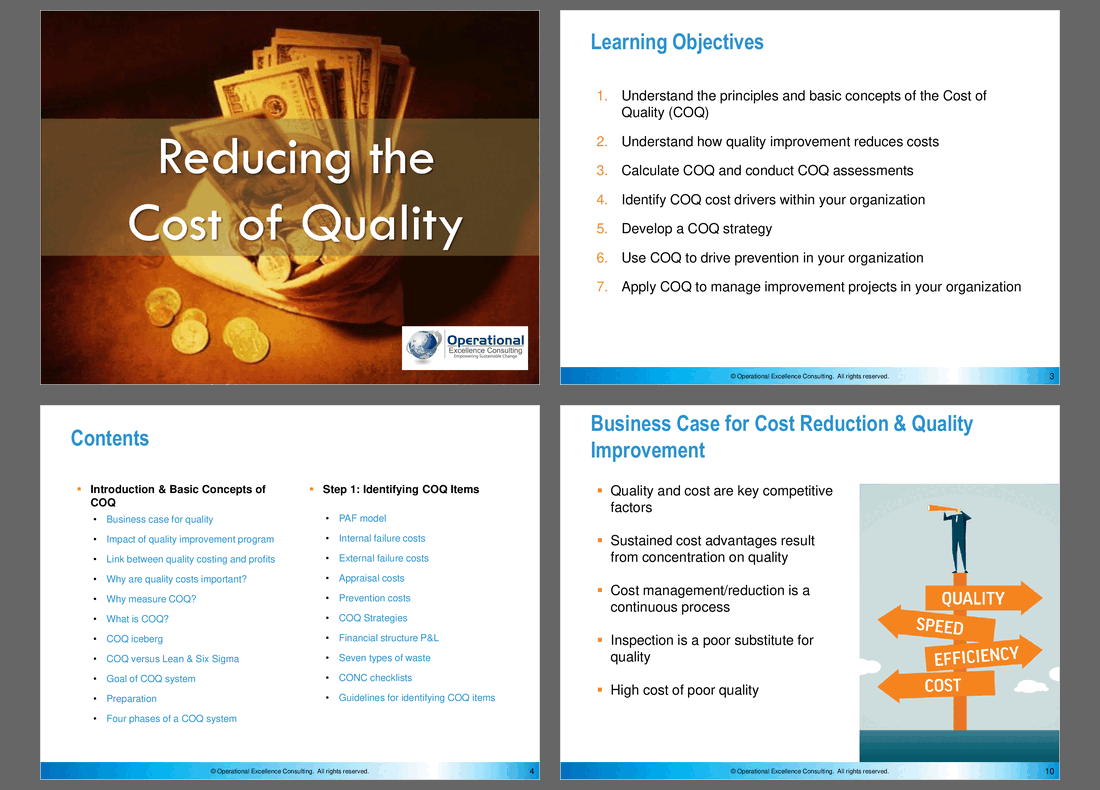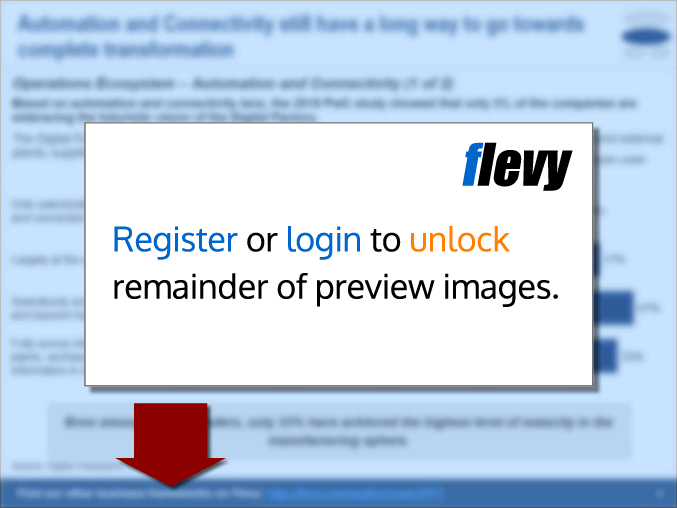Reducing the Cost of Quality (COQ) (PowerPoint PPTX Slide Deck)
PowerPoint (PPTX) 131 Slides
BENEFITS OF THIS POWERPOINT DOCUMENT
- Provides a framework for reducing costs based on the COQ approach to quality improvement.
- Provides guidelines on how to identify, measure and analyze items related to the Cost of Non-Conformance (CONC) and the Cost of Conformance (COC).
- Provides a cost management system to support your continuous improvement or Lean Six Sigma program.
QUALITY MANAGEMENT PPT DESCRIPTION
Successful companies know it's far cheaper to prevent problems than to fix them—especially after customers notice. Poor quality increases costs and erodes competitive advantage, while good quality reduces costs and strengthens market position. The key question is: How can a company measure and improve quality performance?
The answer lies in implementing a Cost of Quality (COQ) system.
COQ is a business measurement approach that quantifies the financial impact of delivering—or failing to deliver—quality products and services. It includes both the Cost of Conformance (COC)—the cost of doing things right (e.g., prevention and appraisal), and the Cost of Non-Conformance (CONC)—the cost of doing things wrong (e.g., internal and external failures). Together, these form the PAF model: Prevention, Appraisal, and Failure.
The goal of measuring COQ is to support quality improvement, reduce waste, boost customer satisfaction, and ultimately grow revenue. A key performance indicator is Total COQ as a percentage of Sales Turnover, which allows organizations to track performance and set improvement targets.
The "Reducing the Cost of Quality" training presentation guides you through four essential steps to implement a COQ measurement system: Identification, Collection, Reporting & Analysis, and Cost Reduction.
By using this approach, organizations can prioritize high-impact quality improvements, focus on prevention over correction, and ensure long-term value creation.
LEARNING OBJECTIVES
1. Understand the principles and basic concepts of the Cost of Quality (COQ).
2. Understand how quality improvement reduces costs.
3. Calculate COQ and conduct COQ assessments.
4. Identify COQ cost drivers within your organization.
5. Develop a COQ strategy.
6. Use COQ to drive prevention in your organization.
7. Apply COQ to manage improvement projects in your organization.
CONTENTS
1. Introduction and Basic Concepts of COQ
• Business case for quality
• Impact of quality improvement program
• Link between quality costing and profits
• Why are quality costs important?
• Why measure COQ?
• What is COQ?
• COQ iceberg model
• COQ versus Lean & Six Sigma
• Goal of COQ system
• Preparation
• Four phases of a COQ system
2. Step 1: Identifying COQ Items
• PAF model
• Prevention costs
• Appraisal costs
• Failure costs
• Internal failure costs
• External failure costs
• Eight types of waste
• CONC checklists
• Guidelines for identifying COQ items
3. Step 2: Collecting COQ Data
• Matching accounts with CONC items
• Quality costing
• COQ Data source
• Example calculations of Failure cost, Appraisal cost and Prevention cost
• COQ scorecard and indices
• Process flow for COQ reporting
• Collecting and reporting COQ data
• Role of Finance
• Role of line managers/supervisors
• Practical guidelines
4. Step 3: Analyzing COQ Data
• Selecting quality cost bases
• Trends analysis
• Pareto analysis
• Variance analysis
• SMART criteria
• Set targets for improvement
• Case study
5. Step 4: Reducing COQ & Improving Quality
• Reduce COQ through quality improvement programs
• Tools and techniques
• System for quality is prevention
• Some results from industries
• Sustaining COQ
This presentation includes real-world examples, such as the Tylenol recall, to illustrate the impact of poor quality on a company's bottom line. It also emphasizes the importance of continuous cost management and the role of finance in tracking COQ.
Got a question about the product? Email us at support@flevy.com or ask the author directly by using the "Ask the Author a Question" form. If you cannot view the preview above this document description, go here to view the large preview instead.
Source: Best Practices in Quality Management, Cost Reduction Assessment, COQ PowerPoint Slides: Reducing the Cost of Quality (COQ) PowerPoint (PPTX) Presentation Slide Deck, Operational Excellence Consulting









